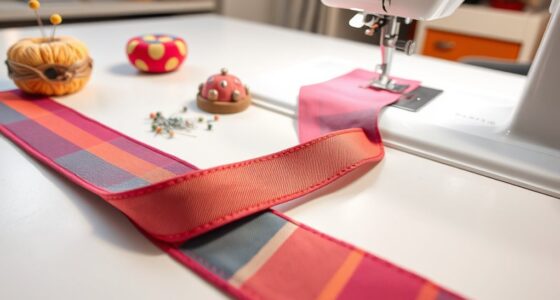Modern sashiko revives a 400-year-old Japanese embroidery technique, blending traditional patterns with new designs to enhance today’s textiles. By using simple stitches and geometric motifs, you can create durable, beautiful pieces that honor Japan’s cultural heritage. This slow, mindful craft connects you to a rich history while allowing for innovative expression in fashion, home decor, or repairs. If you stay curious, you’ll discover how this ancient stitch continues to inspire contemporary creativity.
Key Takeaways
- Modern sashiko blends traditional geometric patterns with contemporary designs for versatile textiles and fashion.
- Artists adapt sashiko techniques using new materials, making it accessible for everyday creative projects.
- Revival efforts emphasize cultural preservation while inspiring innovative, sustainable textile practices.
- Contemporary sashiko promotes mindfulness, craftsmanship, and community engagement through slow, deliberate stitching.
- Integration of traditional motifs into modern products maintains cultural heritage and appeals to diverse aesthetic preferences.

Sashiko, a traditional Japanese embroidery technique dating back over 400 years, is experiencing a vibrant revival today. This ancient craft isn’t just about creating beautiful patterns; it’s a preserved form of cultural heritage that connects you to Japan’s history and craftsmanship. As you explore sashiko, you’ll discover that its simple yet intricate embroidery techniques serve both aesthetic and practical purposes. Originally, sashiko was used to reinforce clothing and household textiles, making them more durable in colder climates. Today, these techniques inspire modern artisans and enthusiasts alike, blending tradition with contemporary design.
Sashiko is a 400-year-old Japanese embroidery craft blending tradition, practicality, and modern artistry.
When you learn sashiko, you’re engaging with a set of embroidery techniques that emphasize geometric patterns, repetitive stitches, and minimalistic beauty. You’ll use a needle and white or indigo thread on dark fabric, creating striking contrast that highlights each stitch. The process is meditative and precise, requiring patience and attention to detail, which deepens your appreciation for the cultural heritage embedded in each piece. Unlike other embroidery styles, sashiko’s stitches are often uniform and evenly spaced, reflecting a harmony that’s rooted in its history. This consistency isn’t just for aesthetics—it also guarantees the fabric’s strength and longevity.
The resurgence of sashiko today is driven by a desire to preserve and honor this cultural heritage while adapting it to modern textiles. You might see sashiko-inspired fashion, home decor, or accessories that retain its traditional motifs but are made with contemporary materials. By incorporating sashiko into your projects, you participate in a living tradition that has survived centuries of change. You’re not only creating something beautiful but also contributing to the cultural continuity that keeps this heritage relevant. Modern sashiko often combines classic patterns with new ideas, making it accessible and appealing to a broader audience.
Learning sashiko encourages you to embrace sustainable and mindful crafting. Its embroidery techniques promote slow, deliberate work, fostering a deeper connection to your creations. As you stitch, you’re part of a community that values craftsmanship, history, and cultural expression. Whether you’re repairing old garments or designing new pieces, sashiko offers a meaningful way to honor Japan’s cultural heritage while making something uniquely your own. This revival isn’t just about aesthetics; it’s about keeping alive a tradition that embodies resilience, simplicity, and beauty—values that resonate as strongly today as they did four centuries ago. Additionally, practicing sashiko can enhance your color accuracy skills, as selecting the right threads and fabrics plays a vital role in achieving authentic results.
Frequently Asked Questions
Can Sashiko Be Adapted for Modern Fashion Accessories?
You can definitely adapt sashiko for modern fashion accessories by combining recycled fabrics with minimalist design. Use sashiko stitches to add subtle texture and visual interest to items like bags, jewelry, or clothing accents. This approach not only highlights sustainability but also creates unique, stylish pieces that blend traditional craftsmanship with contemporary aesthetics, making your accessories stand out while honoring a 400-year-old textile art form.
What Are the Environmental Benefits of Sashiko Stitching?
Imagine sashiko as a gentle rain nurturing the Earth. By using recyclable materials, you help reduce waste and lessen environmental impact. This traditional stitching technique promotes sustainability, turning scraps into beautiful textiles rather than trash. When you embrace sashiko, you’re weaving a greener future—one stitch at a time—preserving resources and celebrating eco-conscious craftsmanship in modern fashion and textiles.
How Does Sashiko Influence Contemporary Textile Sustainability?
You see that sashiko influences contemporary textile sustainability by promoting cultural preservation and reducing ecological impact. When you embrace sashiko, you help keep traditional craftsmanship alive, fostering a deeper appreciation for cultural heritage. Additionally, sashiko’s emphasis on repairing and reusing textiles minimizes waste, supporting eco-friendly practices. This mindful approach encourages a more sustainable textile industry, blending cultural value with ecological responsibility for a better, more conscious future.
Are There Digital Tools to Learn Sashiko Techniques?
Imagine finding a cozy corner to learn a timeless craft. You can explore digital tutorials and join virtual workshops to master sashiko techniques from the comfort of your home. These online resources guide you through stitches and patterns step-by-step, making it easier to revive this historic art. Whether you’re a beginner or experienced, digital tools open doors to preserving and practicing sashiko, ensuring its beauty continues into the future.
How Can Sashiko Be Integrated Into Mixed-Media Art Projects?
You can integrate sashiko into mixed-media art projects by using it as embroidery embellishments on fabric layers. Experiment with textile layering to add depth, combining sashiko stitching with other materials like paper or paint. Incorporate sashiko stitches into your designs to create texture and contrast, blending traditional techniques with contemporary art. This approach transforms sashiko from a functional stitch into a dynamic element enhancing your mixed-media artwork.
Conclusion
As you embrace sashiko, imagine your hands guiding the needle through soft fabric, creating intricate patterns that tell stories centuries old. Feel the rhythmic pull, like waves gently lapping a shoreline, reviving a tradition that bridges past and present. With each stitch, you’re weaving history into your textiles, transforming simple cloth into art. Keep sewing, and let this ancient craft inspire your modern creations—where tradition and innovation beautifully intertwine under your fingertips.









